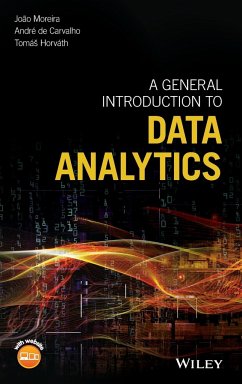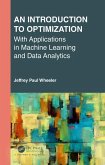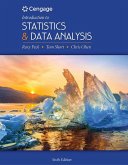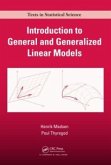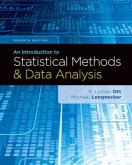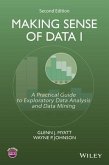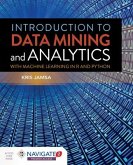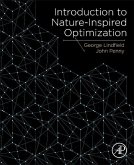- Gebundenes Buch
- Merkliste
- Auf die Merkliste
- Bewerten Bewerten
- Teilen
- Produkt teilen
- Produkterinnerung
- Produkterinnerung
A guide to the principles and methods of data analysis that does not require knowledge of statistics or programming A General Introduction to Data Analytics is an essential guide to understand and use data analytics. This book is written using easy-to-understand terms and does not require familiarity with statistics or programming. The authors--noted experts in the field--highlight an explanation of the intuition behind the basic data analytics techniques. The text also contains exercises and illustrative examples. Thought to be easily accessible to non-experts, the book provides motivation to…mehr
Andere Kunden interessierten sich auch für
![An Introduction to Optimization with Applications in Machine Learning and Data Analytics An Introduction to Optimization with Applications in Machine Learning and Data Analytics]() Jeffrey Paul WheelerAn Introduction to Optimization with Applications in Machine Learning and Data Analytics101,99 €
Jeffrey Paul WheelerAn Introduction to Optimization with Applications in Machine Learning and Data Analytics101,99 €![Introduction to Statistics and Data Analysis Introduction to Statistics and Data Analysis]() Roxy Peck (San Luis Obispo California Polytechnic State UniversityIntroduction to Statistics and Data Analysis295,99 €
Roxy Peck (San Luis Obispo California Polytechnic State UniversityIntroduction to Statistics and Data Analysis295,99 €![Introduction to General and Generalized Linear Models Introduction to General and Generalized Linear Models]() Henrik MadsenIntroduction to General and Generalized Linear Models74,99 €
Henrik MadsenIntroduction to General and Generalized Linear Models74,99 €![An Introduction to Statistical Methods and Data Analysis An Introduction to Statistical Methods and Data Analysis]() R. OttAn Introduction to Statistical Methods and Data Analysis117,99 €
R. OttAn Introduction to Statistical Methods and Data Analysis117,99 €![Making Sense of Data I Making Sense of Data I]() Glenn J. Myatt (Inc. Leadscope)Making Sense of Data I85,99 €
Glenn J. Myatt (Inc. Leadscope)Making Sense of Data I85,99 €![Introduction to Data Mining and Analytics Introduction to Data Mining and Analytics]() Kris JamsaIntroduction to Data Mining and Analytics195,99 €
Kris JamsaIntroduction to Data Mining and Analytics195,99 €![Introduction to Nature-Inspired Optimization Introduction to Nature-Inspired Optimization]() George Lindfield (School of Engineering Professor and Applied ScieIntroduction to Nature-Inspired Optimization131,99 €
George Lindfield (School of Engineering Professor and Applied ScieIntroduction to Nature-Inspired Optimization131,99 €-
-
-
A guide to the principles and methods of data analysis that does not require knowledge of statistics or programming A General Introduction to Data Analytics is an essential guide to understand and use data analytics. This book is written using easy-to-understand terms and does not require familiarity with statistics or programming. The authors--noted experts in the field--highlight an explanation of the intuition behind the basic data analytics techniques. The text also contains exercises and illustrative examples. Thought to be easily accessible to non-experts, the book provides motivation to the necessity of analyzing data. It explains how to visualize and summarize data, and how to find natural groups and frequent patterns in a dataset. The book also explores predictive tasks, be them classification or regression. Finally, the book discusses popular data analytic applications, like mining the web, information retrieval, social network analysis, working with text, and recommender systems. The learning resources offer: * A guide to the reasoning behind data mining techniques * A unique illustrative example that extends throughout all the chapters * Exercises at the end of each chapter and larger projects at the end of parts II and III of the book * Supplemented with PowerPoint slides available for instructors on a Wiley Book Companion Site Together with these learning resources, the book can be used in a 13-week course guide, one chapter per course topic. The book was written in a format that allows the understanding of the main data analytics concepts by non-mathematicians, non-statisticians and non-computer scientists interested in getting an introduction to data science. A General Introduction to Data Analytics is a basic guide to data analytics written in highly accessible terms.
Hinweis: Dieser Artikel kann nur an eine deutsche Lieferadresse ausgeliefert werden.
Hinweis: Dieser Artikel kann nur an eine deutsche Lieferadresse ausgeliefert werden.
Produktdetails
- Produktdetails
- Verlag: John Wiley & Sons Inc
- Seitenzahl: 352
- Erscheinungstermin: 18. Juli 2018
- Englisch
- Abmessung: 235mm x 157mm x 23mm
- Gewicht: 712g
- ISBN-13: 9781119296249
- ISBN-10: 1119296242
- Artikelnr.: 53021344
- Herstellerkennzeichnung
- Libri GmbH
- Europaallee 1
- 36244 Bad Hersfeld
- gpsr@libri.de
- Verlag: John Wiley & Sons Inc
- Seitenzahl: 352
- Erscheinungstermin: 18. Juli 2018
- Englisch
- Abmessung: 235mm x 157mm x 23mm
- Gewicht: 712g
- ISBN-13: 9781119296249
- ISBN-10: 1119296242
- Artikelnr.: 53021344
- Herstellerkennzeichnung
- Libri GmbH
- Europaallee 1
- 36244 Bad Hersfeld
- gpsr@libri.de
João Mendes Moreira, PhD, is an assistant professor in the Faculty of Engineering at the University of Porto, Porto, Portugal and is also a researcher in LIAAD-INESC TEC, Porto, Portugal. André de Carvalho, PhD, is a full professor in the Institute of Mathematics and Computer Science at the University of São Paulo, Brazil. Tomá Horváth, PhD, is an assistant professor at the Faculty of Informatics of the Eötvös Loránd University in Budapest, Hungary, and is also associated with the Faculty of Science at the Pavol Jozef afárik University in Koice, Slovakia.
Preface xiii Acknowledgments xv Presentational Conventions xvii About the Companion Website xix Part I Introductory Background 1 1 What Can We Do With Data? 3 1.1 Big Data and Data Science 4 1.2 Big Data Architectures 5 1.3 Small Data 6 1.4 What is Data? 7 1.5 A Short Taxonomy of Data Analytics 9 1.6 Examples of Data Use 10 1.6.1 Breast Cancer in Wisconsin 11 1.6.2 Polish Company Insolvency Data 11 1.7 A Project on Data Analytics 12 1.7.1 A Little History on Methodologies for Data Analytics 12 1.7.2 The KDD Process 14 1.7.3 The CRISP-DM Methodology 15 1.8 How this Book is Organized 16 1.9 Who Should Read this Book 18 Part II Getting Insights from Data 19 2 Descriptive Statistics 21 2.1 Scale Types 22 2.2 Descriptive Univariate Analysis 25 2.2.1 Univariate Frequencies 25 2.2.2 Univariate Data Visualization 27 2.2.3 Univariate Statistics 32 2.2.4 Common Univariate Probability Distributions 38 2.3 Descriptive Bivariate Analysis 40 2.3.1 Two Quantitative Attributes 41 2.3.2 Two Qualitative Attributes, at Least one of them Nominal 45 2.3.3 Two Ordinal Attributes 46 2.4 Final Remarks 47 2.5 Exercises 47 3 Descriptive Multivariate Analysis 49 3.1 Multivariate Frequencies 49 3.2 Multivariate Data Visualization 50 3.3 Multivariate Statistics 59 3.3.1 Location Multivariate Statistics 59 3.3.2 Dispersion Multivariate Statistics 60 3.4 Infographics and Word Clouds 66 3.4.1 Infographics 66 3.4.2 Word Clouds 67 3.5 Final Remarks 67 3.6 Exercises 68 4 Data Quality and Preprocessing 71 4.1 Data Quality 71 4.1.1 Missing Values 72 4.1.2 Redundant Data 74 4.1.3 Inconsistent Data 75 4.1.4 Noisy Data 76 4.1.5 Outliers 77 4.2 Converting to a Di
erent Scale Type 77 4.2.1 Converting Nominal to Relative 78 4.2.2 Converting Ordinal to Relative or Absolute 81 4.2.3 Converting Relative or Absolute to Ordinal or Nominal 82 4.3 Converting to a Di
erent Scale 83 4.4 Data Transformation 85 4.5 Dimensionality Reduction 86 4.5.1 Attribute Aggregation 88 4.5.1.1 Principal Component Analysis 88 4.5.1.2 Independent Component Analysis 91 4.5.1.3 Multidimensional Scaling 91 4.5.2 Attribute Selection 92 4.5.2.1 Filters 92 4.5.2.2 Wrappers 93 4.5.2.3 Embedded 94 4.5.2.4 Search Strategies 95 4.6 Final Remarks 96 4.7 Exercises 96 5 Clustering 99 5.1 Distance Measures 100 5.1.1 Di
erences between Values of Common Attribute Types 101 5.1.2 Distance Measures for Objects with Quantitative Attributes 103 5.1.3 Distance Measures for Non-conventional Attributes 104 5.2 Clustering Validation 107 5.3 Clustering Techniques 108 5.3.1 K-means 110 5.3.1.1 Centroids and Distance Measures 110 5.3.1.2 How K-means Works 111 5.3.2 DBSCAN 115 5.3.3 Agglomerative Hierarchical Clustering Technique 117 5.3.3.1 Linkage Criterion 119 5.3.3.2 Dendrograms 120 5.4 Final Remarks 122 5.5 Exercises 123 6 Frequent Pattern Mining 125 6.1 Frequent Itemsets 127 6.1.1 Setting the min_sup Threshold 128 6.1.2 Apriori - a Join-based Method 131 6.1.3 Eclat 133 6.1.4 FP-Growth 134 6.1.5 Maximal and Closed Frequent Itemsets 138 6.2 Association Rules 139 6.3 Behind Support and Con
dence 142 6.3.1 Cross-support Patterns 143 6.3.2 Lift 144 6.3.3 Simpson's Paradox 145 6.4 Other Types of Pattern 147 6.4.1 Sequential patterns 147 6.4.2 Frequent Sequence Mining 148 6.4.3 Closed and Maximal Sequences 148 6.5 Final Remarks 149 6.6 Exercises 149 7 Cheat Sheet and Project on Descriptive Analytics 151 7.1 Cheat Sheet of Descriptive Analytics 151 7.1.1 On Data Summarization 151 7.1.2 On Clustering 151 7.1.3 On Frequent Pattern Mining 153 7.2 Project on Descriptive Analytics 154 7.2.1 Business Understanding 154 7.2.2 Data Understanding 155 7.2.3 Data Preparation 155 7.2.4 Modeling 157 7.2.5 Evaluation 158 7.2.6 Deployment 158 Part III Predicting the Unknown 159 8 Regression 161 8.1 Predictive Performance Estimation 164 8.1.1 Generalization 164 8.1.2 Model Validation 165 8.1.3 Predictive Performance Measures for Regression 169 8.2 Finding the Parameters of the Model 171 8.2.1 Linear Regression 171 8.2.1.1 Empirical Error 173 8.2.2 The Bias-variance Trade-ö 175 8.2.3 Shrinkage Methods 177 8.2.3.1 Ridge Regression 179 8.2.3.2 Lasso Regression 180 8.2.4 Methods that use Linear Combinations of Attributes 181 8.2.4.1 Principal Components Regression 181 8.2.4.2 Partial Least Squares Regression 182 8.3 Technique and Model Selection 182 8.4 Final Remarks 183 8.5 Exercises 184 9 Classi
cation 187 9.1 Binary Classi
cation 188 9.2 Predictive Performance Measures for Classi
cation 192 9.3 Distance-based Learning Algorithms 199 9.3.1 K-nearest Neighbor Algorithms 199 9.3.2 Case-based Reasoning 202 9.4 Probabilistic Classi
cation Algorithms 203 9.4.1 Logistic Regression Algorithm 205 9.4.2 Naive Bayes Algorithm 207 9.5 Final Remarks 208 9.6 Exercises 210 10 Additional Predictive Methods 211 10.1 Search-based Algorithms 211 10.1.1 Decision Tree Induction Algorithms 212 10.1.2 Decision Trees for Regression 217 10.1.2.1 Model Trees 218 10.1.2.2 Multivariate Adaptive Regression Splines 219 10.2 Optimization-based Algorithms 221 10.2.1 Arti
cial Neural Networks 222 10.2.1.1 Backpropagation 224 10.2.1.2 Deep Networks and Deep Learning Algorithms 230 10.2.2 Support Vector Machines 233 10.2.2.1 SVM for Regression 237 10.3 Final Remarks 238 10.4 Exercises 239 11 Advanced Predictive Topics 241 11.1 Ensemble Learning 241 11.1.1 Bagging 243 11.1.2 Random Forests 244 11.1.3 AdaBoost 245 11.2 Algorithm Bias 246 11.3 Non-binary Classi
cation Tasks 248 11.3.1 One-class Classi
cation 248 11.3.2 Multi-class Classi
cation 249 11.3.3 Ranking Classi
cation 250 11.3.4 Multi-label Classi
cation 251 11.3.5 Hierarchical Classi
cation 252 11.4 Advanced Data Preparation Techniques for Prediction 253 11.4.1 Imbalanced Data Classi
cation 253 11.4.2 For Incomplete Target Labeling 254 11.4.2.1 Semi-supervised Learning 254 11.4.2.2 Active Learning 255 11.5 Description and Prediction with Supervised Interpretable Techniques 255 11.6 Exercises 256 12 Cheat Sheet and Project on Predictive Analytics 259 12.1 Cheat Sheet on Predictive Analytics 259 12.2 Project on Predictive Analytics 259 12.2.1 Business Understanding 260 12.2.2 Data Understanding 260 12.2.3 Data Preparation 265 12.2.4 Modeling 265 12.2.5 Evaluation 265 12.2.6 Deployment 266 Part IV Popular Data Analytics Applications 267 13 Applications for Text, Web and Social Media 269 13.1 Working with Texts 269 13.1.1 Data Acquisition 271 13.1.2 Feature Extraction 271 13.1.2.1 Tokenization 272 13.1.2.2 Stemming 272 13.1.2.3 Conversion to Structured Data 275 13.1.2.4 Is the Bag of Words Enough? 276 13.1.3 Remaining Phases 277 13.1.4 Trends 277 13.1.4.1 Sentiment Analysis 278 13.1.4.2 Web Mining 278 13.2 Recommender Systems 278 13.2.1 Feedback 279 13.2.2 Recommendation Tasks 280 13.2.3 Recommendation Techniques 281 13.2.3.1 Knowledge-based Techniques 281 13.2.3.2 Content-based Techniques 282 13.2.3.3 Collaborative Filtering Techniques 282 13.2.4 Final Remarks 289 13.3 Social Network Analysis 291 13.3.1 Representing Social Networks 291 13.3.2 Basic Properties of Nodes 294 13.3.2.1 Degree 294 13.3.2.2 Distance 294 13.3.2.3 Closeness 295 13.3.2.4 Betweenness 296 13.3.2.5 Clustering Coe
cient 297 13.3.3 Basic and Structural Properties of Networks 297 13.3.3.1 Diameter 297 13.3.3.2 Centralization 297 13.3.3.3 Cliques 299 13.3.3.4 Clustering Coe
cient 299 13.3.3.5 Modularity 299 13.3.4 Trends and Final Remarks 299 13.4 Exercises 300 Apendix A: Comprehensive Description of the CRISP-DM Methodology 303 References 311 Index 315
erent Scale Type 77 4.2.1 Converting Nominal to Relative 78 4.2.2 Converting Ordinal to Relative or Absolute 81 4.2.3 Converting Relative or Absolute to Ordinal or Nominal 82 4.3 Converting to a Di
erent Scale 83 4.4 Data Transformation 85 4.5 Dimensionality Reduction 86 4.5.1 Attribute Aggregation 88 4.5.1.1 Principal Component Analysis 88 4.5.1.2 Independent Component Analysis 91 4.5.1.3 Multidimensional Scaling 91 4.5.2 Attribute Selection 92 4.5.2.1 Filters 92 4.5.2.2 Wrappers 93 4.5.2.3 Embedded 94 4.5.2.4 Search Strategies 95 4.6 Final Remarks 96 4.7 Exercises 96 5 Clustering 99 5.1 Distance Measures 100 5.1.1 Di
erences between Values of Common Attribute Types 101 5.1.2 Distance Measures for Objects with Quantitative Attributes 103 5.1.3 Distance Measures for Non-conventional Attributes 104 5.2 Clustering Validation 107 5.3 Clustering Techniques 108 5.3.1 K-means 110 5.3.1.1 Centroids and Distance Measures 110 5.3.1.2 How K-means Works 111 5.3.2 DBSCAN 115 5.3.3 Agglomerative Hierarchical Clustering Technique 117 5.3.3.1 Linkage Criterion 119 5.3.3.2 Dendrograms 120 5.4 Final Remarks 122 5.5 Exercises 123 6 Frequent Pattern Mining 125 6.1 Frequent Itemsets 127 6.1.1 Setting the min_sup Threshold 128 6.1.2 Apriori - a Join-based Method 131 6.1.3 Eclat 133 6.1.4 FP-Growth 134 6.1.5 Maximal and Closed Frequent Itemsets 138 6.2 Association Rules 139 6.3 Behind Support and Con
dence 142 6.3.1 Cross-support Patterns 143 6.3.2 Lift 144 6.3.3 Simpson's Paradox 145 6.4 Other Types of Pattern 147 6.4.1 Sequential patterns 147 6.4.2 Frequent Sequence Mining 148 6.4.3 Closed and Maximal Sequences 148 6.5 Final Remarks 149 6.6 Exercises 149 7 Cheat Sheet and Project on Descriptive Analytics 151 7.1 Cheat Sheet of Descriptive Analytics 151 7.1.1 On Data Summarization 151 7.1.2 On Clustering 151 7.1.3 On Frequent Pattern Mining 153 7.2 Project on Descriptive Analytics 154 7.2.1 Business Understanding 154 7.2.2 Data Understanding 155 7.2.3 Data Preparation 155 7.2.4 Modeling 157 7.2.5 Evaluation 158 7.2.6 Deployment 158 Part III Predicting the Unknown 159 8 Regression 161 8.1 Predictive Performance Estimation 164 8.1.1 Generalization 164 8.1.2 Model Validation 165 8.1.3 Predictive Performance Measures for Regression 169 8.2 Finding the Parameters of the Model 171 8.2.1 Linear Regression 171 8.2.1.1 Empirical Error 173 8.2.2 The Bias-variance Trade-ö 175 8.2.3 Shrinkage Methods 177 8.2.3.1 Ridge Regression 179 8.2.3.2 Lasso Regression 180 8.2.4 Methods that use Linear Combinations of Attributes 181 8.2.4.1 Principal Components Regression 181 8.2.4.2 Partial Least Squares Regression 182 8.3 Technique and Model Selection 182 8.4 Final Remarks 183 8.5 Exercises 184 9 Classi
cation 187 9.1 Binary Classi
cation 188 9.2 Predictive Performance Measures for Classi
cation 192 9.3 Distance-based Learning Algorithms 199 9.3.1 K-nearest Neighbor Algorithms 199 9.3.2 Case-based Reasoning 202 9.4 Probabilistic Classi
cation Algorithms 203 9.4.1 Logistic Regression Algorithm 205 9.4.2 Naive Bayes Algorithm 207 9.5 Final Remarks 208 9.6 Exercises 210 10 Additional Predictive Methods 211 10.1 Search-based Algorithms 211 10.1.1 Decision Tree Induction Algorithms 212 10.1.2 Decision Trees for Regression 217 10.1.2.1 Model Trees 218 10.1.2.2 Multivariate Adaptive Regression Splines 219 10.2 Optimization-based Algorithms 221 10.2.1 Arti
cial Neural Networks 222 10.2.1.1 Backpropagation 224 10.2.1.2 Deep Networks and Deep Learning Algorithms 230 10.2.2 Support Vector Machines 233 10.2.2.1 SVM for Regression 237 10.3 Final Remarks 238 10.4 Exercises 239 11 Advanced Predictive Topics 241 11.1 Ensemble Learning 241 11.1.1 Bagging 243 11.1.2 Random Forests 244 11.1.3 AdaBoost 245 11.2 Algorithm Bias 246 11.3 Non-binary Classi
cation Tasks 248 11.3.1 One-class Classi
cation 248 11.3.2 Multi-class Classi
cation 249 11.3.3 Ranking Classi
cation 250 11.3.4 Multi-label Classi
cation 251 11.3.5 Hierarchical Classi
cation 252 11.4 Advanced Data Preparation Techniques for Prediction 253 11.4.1 Imbalanced Data Classi
cation 253 11.4.2 For Incomplete Target Labeling 254 11.4.2.1 Semi-supervised Learning 254 11.4.2.2 Active Learning 255 11.5 Description and Prediction with Supervised Interpretable Techniques 255 11.6 Exercises 256 12 Cheat Sheet and Project on Predictive Analytics 259 12.1 Cheat Sheet on Predictive Analytics 259 12.2 Project on Predictive Analytics 259 12.2.1 Business Understanding 260 12.2.2 Data Understanding 260 12.2.3 Data Preparation 265 12.2.4 Modeling 265 12.2.5 Evaluation 265 12.2.6 Deployment 266 Part IV Popular Data Analytics Applications 267 13 Applications for Text, Web and Social Media 269 13.1 Working with Texts 269 13.1.1 Data Acquisition 271 13.1.2 Feature Extraction 271 13.1.2.1 Tokenization 272 13.1.2.2 Stemming 272 13.1.2.3 Conversion to Structured Data 275 13.1.2.4 Is the Bag of Words Enough? 276 13.1.3 Remaining Phases 277 13.1.4 Trends 277 13.1.4.1 Sentiment Analysis 278 13.1.4.2 Web Mining 278 13.2 Recommender Systems 278 13.2.1 Feedback 279 13.2.2 Recommendation Tasks 280 13.2.3 Recommendation Techniques 281 13.2.3.1 Knowledge-based Techniques 281 13.2.3.2 Content-based Techniques 282 13.2.3.3 Collaborative Filtering Techniques 282 13.2.4 Final Remarks 289 13.3 Social Network Analysis 291 13.3.1 Representing Social Networks 291 13.3.2 Basic Properties of Nodes 294 13.3.2.1 Degree 294 13.3.2.2 Distance 294 13.3.2.3 Closeness 295 13.3.2.4 Betweenness 296 13.3.2.5 Clustering Coe
cient 297 13.3.3 Basic and Structural Properties of Networks 297 13.3.3.1 Diameter 297 13.3.3.2 Centralization 297 13.3.3.3 Cliques 299 13.3.3.4 Clustering Coe
cient 299 13.3.3.5 Modularity 299 13.3.4 Trends and Final Remarks 299 13.4 Exercises 300 Apendix A: Comprehensive Description of the CRISP-DM Methodology 303 References 311 Index 315
Preface xiii Acknowledgments xv Presentational Conventions xvii About the Companion Website xix Part I Introductory Background 1 1 What Can We Do With Data? 3 1.1 Big Data and Data Science 4 1.2 Big Data Architectures 5 1.3 Small Data 6 1.4 What is Data? 7 1.5 A Short Taxonomy of Data Analytics 9 1.6 Examples of Data Use 10 1.6.1 Breast Cancer in Wisconsin 11 1.6.2 Polish Company Insolvency Data 11 1.7 A Project on Data Analytics 12 1.7.1 A Little History on Methodologies for Data Analytics 12 1.7.2 The KDD Process 14 1.7.3 The CRISP-DM Methodology 15 1.8 How this Book is Organized 16 1.9 Who Should Read this Book 18 Part II Getting Insights from Data 19 2 Descriptive Statistics 21 2.1 Scale Types 22 2.2 Descriptive Univariate Analysis 25 2.2.1 Univariate Frequencies 25 2.2.2 Univariate Data Visualization 27 2.2.3 Univariate Statistics 32 2.2.4 Common Univariate Probability Distributions 38 2.3 Descriptive Bivariate Analysis 40 2.3.1 Two Quantitative Attributes 41 2.3.2 Two Qualitative Attributes, at Least one of them Nominal 45 2.3.3 Two Ordinal Attributes 46 2.4 Final Remarks 47 2.5 Exercises 47 3 Descriptive Multivariate Analysis 49 3.1 Multivariate Frequencies 49 3.2 Multivariate Data Visualization 50 3.3 Multivariate Statistics 59 3.3.1 Location Multivariate Statistics 59 3.3.2 Dispersion Multivariate Statistics 60 3.4 Infographics and Word Clouds 66 3.4.1 Infographics 66 3.4.2 Word Clouds 67 3.5 Final Remarks 67 3.6 Exercises 68 4 Data Quality and Preprocessing 71 4.1 Data Quality 71 4.1.1 Missing Values 72 4.1.2 Redundant Data 74 4.1.3 Inconsistent Data 75 4.1.4 Noisy Data 76 4.1.5 Outliers 77 4.2 Converting to a Di
erent Scale Type 77 4.2.1 Converting Nominal to Relative 78 4.2.2 Converting Ordinal to Relative or Absolute 81 4.2.3 Converting Relative or Absolute to Ordinal or Nominal 82 4.3 Converting to a Di
erent Scale 83 4.4 Data Transformation 85 4.5 Dimensionality Reduction 86 4.5.1 Attribute Aggregation 88 4.5.1.1 Principal Component Analysis 88 4.5.1.2 Independent Component Analysis 91 4.5.1.3 Multidimensional Scaling 91 4.5.2 Attribute Selection 92 4.5.2.1 Filters 92 4.5.2.2 Wrappers 93 4.5.2.3 Embedded 94 4.5.2.4 Search Strategies 95 4.6 Final Remarks 96 4.7 Exercises 96 5 Clustering 99 5.1 Distance Measures 100 5.1.1 Di
erences between Values of Common Attribute Types 101 5.1.2 Distance Measures for Objects with Quantitative Attributes 103 5.1.3 Distance Measures for Non-conventional Attributes 104 5.2 Clustering Validation 107 5.3 Clustering Techniques 108 5.3.1 K-means 110 5.3.1.1 Centroids and Distance Measures 110 5.3.1.2 How K-means Works 111 5.3.2 DBSCAN 115 5.3.3 Agglomerative Hierarchical Clustering Technique 117 5.3.3.1 Linkage Criterion 119 5.3.3.2 Dendrograms 120 5.4 Final Remarks 122 5.5 Exercises 123 6 Frequent Pattern Mining 125 6.1 Frequent Itemsets 127 6.1.1 Setting the min_sup Threshold 128 6.1.2 Apriori - a Join-based Method 131 6.1.3 Eclat 133 6.1.4 FP-Growth 134 6.1.5 Maximal and Closed Frequent Itemsets 138 6.2 Association Rules 139 6.3 Behind Support and Con
dence 142 6.3.1 Cross-support Patterns 143 6.3.2 Lift 144 6.3.3 Simpson's Paradox 145 6.4 Other Types of Pattern 147 6.4.1 Sequential patterns 147 6.4.2 Frequent Sequence Mining 148 6.4.3 Closed and Maximal Sequences 148 6.5 Final Remarks 149 6.6 Exercises 149 7 Cheat Sheet and Project on Descriptive Analytics 151 7.1 Cheat Sheet of Descriptive Analytics 151 7.1.1 On Data Summarization 151 7.1.2 On Clustering 151 7.1.3 On Frequent Pattern Mining 153 7.2 Project on Descriptive Analytics 154 7.2.1 Business Understanding 154 7.2.2 Data Understanding 155 7.2.3 Data Preparation 155 7.2.4 Modeling 157 7.2.5 Evaluation 158 7.2.6 Deployment 158 Part III Predicting the Unknown 159 8 Regression 161 8.1 Predictive Performance Estimation 164 8.1.1 Generalization 164 8.1.2 Model Validation 165 8.1.3 Predictive Performance Measures for Regression 169 8.2 Finding the Parameters of the Model 171 8.2.1 Linear Regression 171 8.2.1.1 Empirical Error 173 8.2.2 The Bias-variance Trade-ö 175 8.2.3 Shrinkage Methods 177 8.2.3.1 Ridge Regression 179 8.2.3.2 Lasso Regression 180 8.2.4 Methods that use Linear Combinations of Attributes 181 8.2.4.1 Principal Components Regression 181 8.2.4.2 Partial Least Squares Regression 182 8.3 Technique and Model Selection 182 8.4 Final Remarks 183 8.5 Exercises 184 9 Classi
cation 187 9.1 Binary Classi
cation 188 9.2 Predictive Performance Measures for Classi
cation 192 9.3 Distance-based Learning Algorithms 199 9.3.1 K-nearest Neighbor Algorithms 199 9.3.2 Case-based Reasoning 202 9.4 Probabilistic Classi
cation Algorithms 203 9.4.1 Logistic Regression Algorithm 205 9.4.2 Naive Bayes Algorithm 207 9.5 Final Remarks 208 9.6 Exercises 210 10 Additional Predictive Methods 211 10.1 Search-based Algorithms 211 10.1.1 Decision Tree Induction Algorithms 212 10.1.2 Decision Trees for Regression 217 10.1.2.1 Model Trees 218 10.1.2.2 Multivariate Adaptive Regression Splines 219 10.2 Optimization-based Algorithms 221 10.2.1 Arti
cial Neural Networks 222 10.2.1.1 Backpropagation 224 10.2.1.2 Deep Networks and Deep Learning Algorithms 230 10.2.2 Support Vector Machines 233 10.2.2.1 SVM for Regression 237 10.3 Final Remarks 238 10.4 Exercises 239 11 Advanced Predictive Topics 241 11.1 Ensemble Learning 241 11.1.1 Bagging 243 11.1.2 Random Forests 244 11.1.3 AdaBoost 245 11.2 Algorithm Bias 246 11.3 Non-binary Classi
cation Tasks 248 11.3.1 One-class Classi
cation 248 11.3.2 Multi-class Classi
cation 249 11.3.3 Ranking Classi
cation 250 11.3.4 Multi-label Classi
cation 251 11.3.5 Hierarchical Classi
cation 252 11.4 Advanced Data Preparation Techniques for Prediction 253 11.4.1 Imbalanced Data Classi
cation 253 11.4.2 For Incomplete Target Labeling 254 11.4.2.1 Semi-supervised Learning 254 11.4.2.2 Active Learning 255 11.5 Description and Prediction with Supervised Interpretable Techniques 255 11.6 Exercises 256 12 Cheat Sheet and Project on Predictive Analytics 259 12.1 Cheat Sheet on Predictive Analytics 259 12.2 Project on Predictive Analytics 259 12.2.1 Business Understanding 260 12.2.2 Data Understanding 260 12.2.3 Data Preparation 265 12.2.4 Modeling 265 12.2.5 Evaluation 265 12.2.6 Deployment 266 Part IV Popular Data Analytics Applications 267 13 Applications for Text, Web and Social Media 269 13.1 Working with Texts 269 13.1.1 Data Acquisition 271 13.1.2 Feature Extraction 271 13.1.2.1 Tokenization 272 13.1.2.2 Stemming 272 13.1.2.3 Conversion to Structured Data 275 13.1.2.4 Is the Bag of Words Enough? 276 13.1.3 Remaining Phases 277 13.1.4 Trends 277 13.1.4.1 Sentiment Analysis 278 13.1.4.2 Web Mining 278 13.2 Recommender Systems 278 13.2.1 Feedback 279 13.2.2 Recommendation Tasks 280 13.2.3 Recommendation Techniques 281 13.2.3.1 Knowledge-based Techniques 281 13.2.3.2 Content-based Techniques 282 13.2.3.3 Collaborative Filtering Techniques 282 13.2.4 Final Remarks 289 13.3 Social Network Analysis 291 13.3.1 Representing Social Networks 291 13.3.2 Basic Properties of Nodes 294 13.3.2.1 Degree 294 13.3.2.2 Distance 294 13.3.2.3 Closeness 295 13.3.2.4 Betweenness 296 13.3.2.5 Clustering Coe
cient 297 13.3.3 Basic and Structural Properties of Networks 297 13.3.3.1 Diameter 297 13.3.3.2 Centralization 297 13.3.3.3 Cliques 299 13.3.3.4 Clustering Coe
cient 299 13.3.3.5 Modularity 299 13.3.4 Trends and Final Remarks 299 13.4 Exercises 300 Apendix A: Comprehensive Description of the CRISP-DM Methodology 303 References 311 Index 315
erent Scale Type 77 4.2.1 Converting Nominal to Relative 78 4.2.2 Converting Ordinal to Relative or Absolute 81 4.2.3 Converting Relative or Absolute to Ordinal or Nominal 82 4.3 Converting to a Di
erent Scale 83 4.4 Data Transformation 85 4.5 Dimensionality Reduction 86 4.5.1 Attribute Aggregation 88 4.5.1.1 Principal Component Analysis 88 4.5.1.2 Independent Component Analysis 91 4.5.1.3 Multidimensional Scaling 91 4.5.2 Attribute Selection 92 4.5.2.1 Filters 92 4.5.2.2 Wrappers 93 4.5.2.3 Embedded 94 4.5.2.4 Search Strategies 95 4.6 Final Remarks 96 4.7 Exercises 96 5 Clustering 99 5.1 Distance Measures 100 5.1.1 Di
erences between Values of Common Attribute Types 101 5.1.2 Distance Measures for Objects with Quantitative Attributes 103 5.1.3 Distance Measures for Non-conventional Attributes 104 5.2 Clustering Validation 107 5.3 Clustering Techniques 108 5.3.1 K-means 110 5.3.1.1 Centroids and Distance Measures 110 5.3.1.2 How K-means Works 111 5.3.2 DBSCAN 115 5.3.3 Agglomerative Hierarchical Clustering Technique 117 5.3.3.1 Linkage Criterion 119 5.3.3.2 Dendrograms 120 5.4 Final Remarks 122 5.5 Exercises 123 6 Frequent Pattern Mining 125 6.1 Frequent Itemsets 127 6.1.1 Setting the min_sup Threshold 128 6.1.2 Apriori - a Join-based Method 131 6.1.3 Eclat 133 6.1.4 FP-Growth 134 6.1.5 Maximal and Closed Frequent Itemsets 138 6.2 Association Rules 139 6.3 Behind Support and Con
dence 142 6.3.1 Cross-support Patterns 143 6.3.2 Lift 144 6.3.3 Simpson's Paradox 145 6.4 Other Types of Pattern 147 6.4.1 Sequential patterns 147 6.4.2 Frequent Sequence Mining 148 6.4.3 Closed and Maximal Sequences 148 6.5 Final Remarks 149 6.6 Exercises 149 7 Cheat Sheet and Project on Descriptive Analytics 151 7.1 Cheat Sheet of Descriptive Analytics 151 7.1.1 On Data Summarization 151 7.1.2 On Clustering 151 7.1.3 On Frequent Pattern Mining 153 7.2 Project on Descriptive Analytics 154 7.2.1 Business Understanding 154 7.2.2 Data Understanding 155 7.2.3 Data Preparation 155 7.2.4 Modeling 157 7.2.5 Evaluation 158 7.2.6 Deployment 158 Part III Predicting the Unknown 159 8 Regression 161 8.1 Predictive Performance Estimation 164 8.1.1 Generalization 164 8.1.2 Model Validation 165 8.1.3 Predictive Performance Measures for Regression 169 8.2 Finding the Parameters of the Model 171 8.2.1 Linear Regression 171 8.2.1.1 Empirical Error 173 8.2.2 The Bias-variance Trade-ö 175 8.2.3 Shrinkage Methods 177 8.2.3.1 Ridge Regression 179 8.2.3.2 Lasso Regression 180 8.2.4 Methods that use Linear Combinations of Attributes 181 8.2.4.1 Principal Components Regression 181 8.2.4.2 Partial Least Squares Regression 182 8.3 Technique and Model Selection 182 8.4 Final Remarks 183 8.5 Exercises 184 9 Classi
cation 187 9.1 Binary Classi
cation 188 9.2 Predictive Performance Measures for Classi
cation 192 9.3 Distance-based Learning Algorithms 199 9.3.1 K-nearest Neighbor Algorithms 199 9.3.2 Case-based Reasoning 202 9.4 Probabilistic Classi
cation Algorithms 203 9.4.1 Logistic Regression Algorithm 205 9.4.2 Naive Bayes Algorithm 207 9.5 Final Remarks 208 9.6 Exercises 210 10 Additional Predictive Methods 211 10.1 Search-based Algorithms 211 10.1.1 Decision Tree Induction Algorithms 212 10.1.2 Decision Trees for Regression 217 10.1.2.1 Model Trees 218 10.1.2.2 Multivariate Adaptive Regression Splines 219 10.2 Optimization-based Algorithms 221 10.2.1 Arti
cial Neural Networks 222 10.2.1.1 Backpropagation 224 10.2.1.2 Deep Networks and Deep Learning Algorithms 230 10.2.2 Support Vector Machines 233 10.2.2.1 SVM for Regression 237 10.3 Final Remarks 238 10.4 Exercises 239 11 Advanced Predictive Topics 241 11.1 Ensemble Learning 241 11.1.1 Bagging 243 11.1.2 Random Forests 244 11.1.3 AdaBoost 245 11.2 Algorithm Bias 246 11.3 Non-binary Classi
cation Tasks 248 11.3.1 One-class Classi
cation 248 11.3.2 Multi-class Classi
cation 249 11.3.3 Ranking Classi
cation 250 11.3.4 Multi-label Classi
cation 251 11.3.5 Hierarchical Classi
cation 252 11.4 Advanced Data Preparation Techniques for Prediction 253 11.4.1 Imbalanced Data Classi
cation 253 11.4.2 For Incomplete Target Labeling 254 11.4.2.1 Semi-supervised Learning 254 11.4.2.2 Active Learning 255 11.5 Description and Prediction with Supervised Interpretable Techniques 255 11.6 Exercises 256 12 Cheat Sheet and Project on Predictive Analytics 259 12.1 Cheat Sheet on Predictive Analytics 259 12.2 Project on Predictive Analytics 259 12.2.1 Business Understanding 260 12.2.2 Data Understanding 260 12.2.3 Data Preparation 265 12.2.4 Modeling 265 12.2.5 Evaluation 265 12.2.6 Deployment 266 Part IV Popular Data Analytics Applications 267 13 Applications for Text, Web and Social Media 269 13.1 Working with Texts 269 13.1.1 Data Acquisition 271 13.1.2 Feature Extraction 271 13.1.2.1 Tokenization 272 13.1.2.2 Stemming 272 13.1.2.3 Conversion to Structured Data 275 13.1.2.4 Is the Bag of Words Enough? 276 13.1.3 Remaining Phases 277 13.1.4 Trends 277 13.1.4.1 Sentiment Analysis 278 13.1.4.2 Web Mining 278 13.2 Recommender Systems 278 13.2.1 Feedback 279 13.2.2 Recommendation Tasks 280 13.2.3 Recommendation Techniques 281 13.2.3.1 Knowledge-based Techniques 281 13.2.3.2 Content-based Techniques 282 13.2.3.3 Collaborative Filtering Techniques 282 13.2.4 Final Remarks 289 13.3 Social Network Analysis 291 13.3.1 Representing Social Networks 291 13.3.2 Basic Properties of Nodes 294 13.3.2.1 Degree 294 13.3.2.2 Distance 294 13.3.2.3 Closeness 295 13.3.2.4 Betweenness 296 13.3.2.5 Clustering Coe
cient 297 13.3.3 Basic and Structural Properties of Networks 297 13.3.3.1 Diameter 297 13.3.3.2 Centralization 297 13.3.3.3 Cliques 299 13.3.3.4 Clustering Coe
cient 299 13.3.3.5 Modularity 299 13.3.4 Trends and Final Remarks 299 13.4 Exercises 300 Apendix A: Comprehensive Description of the CRISP-DM Methodology 303 References 311 Index 315

